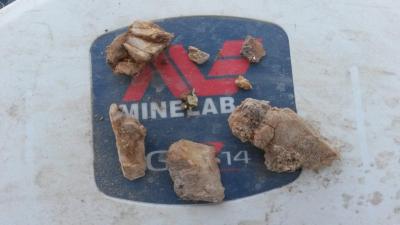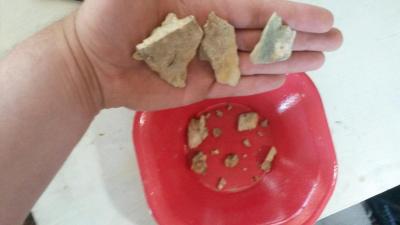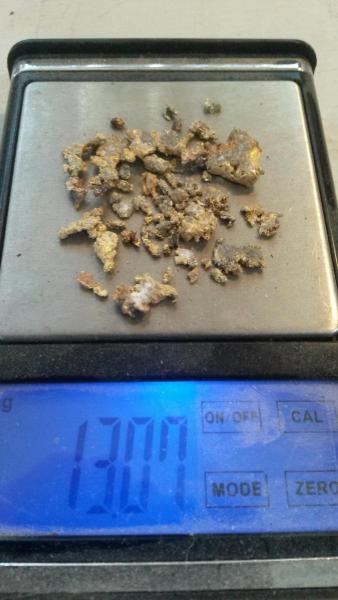-
Posts
2,456 -
Joined
-
Last visited
-
Days Won
38
Content Type
Forums
Detector Prospector Home
Detector Database
Downloads
Everything posted by jasong
-

Keene 6200 Super Max Dredge
jasong replied to sjmpainter's topic in Gold Panning, Sluicing, Dredging, Drywashing, Etc
Interesting. I'd have to see it work in real conditions though. How much 200 mesh gold am I really missing and is it even worth it to spend the extra time to catch it verus running more gravel? That's a huge dredge for a 6", it'd have to be worth it economically move that thing around unless you had a nice slow river you could just drive right up to. -

Infinium Ls / Detecting Gold Question
jasong replied to Oregon Jim's topic in Garrett Metal Detectors
Do they have aftermarket mono coils for it? Seems like it came with a fairly large DD, though I've never used one. Or would at least a smaller DD if they sell such a thing might help a bit? -
Some electronic devices could be damaged by a magnet even if they don't have magnetic storage media if you wave or move the magnet around. The faster it moves the higher the chance of damage. As soon as you start moving a magnet then it's flux cuts different objects at a non-static rate. If that object happens to be a choke in the power circuit, or an inductor in the filtering circuit as is common with detectors, then you can induce voltage spikes. Semiconductors can be very sensitive to voltage spikes, especially microcontrollers, just a few volts too high can toast inputs, so newer detectors may be particularly susceptible. If the magnet is strong enough, like the rare earth ones we put on our picks, then they'll be able to induce a not insignificant amount of current over just single wires or even PCB traces just like they do through inductors because a single straight wire is in fact an inductor too. Actually, I wonder how the new machines deal with the possibility of waving a pick magnet over the coil. Anyways, it's probably not likely to happen, but moving powerful magnets around close to the control box in a rapid fashion could induce voltages high enough to toast semiconductors. Detectors have very poor shielding (well except the metal cased ones), if I put my cell phone up to the GPZ body it goes crazy (can also "hear" the gpz on a hand radio close enough to the case). So, a moving magnet will definitely induce a voltage in coils or wires inside it.
-
I read about this a few years ago, interesting stuff. Article is not exactly accurate to say supernovas aren't enough to produce gold though, gold and other elements past iron are being synthesized in them as well almost certainly. Wether our gold came from supernovas or neutron star collisions or some combo, both are remarkable and just mind blowing to consider! An interesting side note regarding heavy element nucleosythnesis is that we have observed it occuring on Earth. Actually we were responsible for it! Thermonuclear (fusion or h-bombs) weapons synthesize small amounts of heavier elements on detonation which we can observe. Similar to the process inside a supernova except much (much much much) smaller scale. I think they create some of these fancy new elements at the end of the periodic table in particle accelerators too.
-
I don't know if the update had anything to do with it, but I just recently got finished doing a solid day of tests comparing the GPZ to the GPX on an array of different nugget sizes and geometries and contrasting it with the GPZ performance when I first bought the machine in March when I did a similar array of tests. The GPZ is running way (way, way) quieter these days. I filmed my tests the first week I had my GPZ and it was so chattery I thought it was defective and my GPX was just purring along. Now, my GPZ runs substantially more stable both regarding EMI and ground noise than even my trusty old GPX. It's weird how subtle changes over time go unnoticed, but referring back to my original video there is no doubt the machine is running far more stable than it did at first and I don't know if it has to do with the update or just the computer adjusting to the use and different conditions over time or what.
-

Anyone Using The Severe Ground Setting On The GPZ 7000?
jasong replied to fredmason's topic in Minelab Metal Detectors
It's kinda like Sensitive Smooth, a setting I will only use as a last resort and only if I already know there is gold there. I've tested it on a lot of dug and undug nuggets and it loses sensitivity on all sizes of gold, not just small stuff. Like Lunk, I find General/Difficult works for the worst stuff in AZ (I use low or even high smoothing when the ground itself gets bad enough too), just gotta power through the noise and get the Shoe Goo out for the rock kicking. -
Not sure what the upload limits are, but you could throw your vid into Windows Live Movie Maker and render it down to a compressed format and reduce the resolution. 1 gig can turn into 50-75mb or so if the proper compression is installed. Or set the recording options to something much lower in your phone/camera, they are probably defaulting to 1080p which is way higher than what is needed for internet vids. 720p is probably even still overkill for just showing a detector. Hosting vids locally could take a ton of bandwidth if they aren't compressed and you end up with a lot of external traffic from links.
-
Ugh, gnarly. That stuff is the single reason I don't detect the Sierras. Is there some way a guy can determine if he's immune to it short of finding some and touching it? I'm not sure where I could even find it.
-
Just a heads up, you can stake claims, prospect, and mine in WSA's. Just can't do it if it gets redesignated as an actual Wilderness unless you are grandfathered in. Someone correct me if I'm wrong, but when I checked into a while back that was the case, haven't heard of any new laws that would change it.
-

GPZ Low-high Signals And High Yield Vs General
jasong replied to jasong's topic in Minelab Metal Detectors
You mean low-high right? Otherwise you are confirming my alloy/purity thoughts above since you are in lower avg purity gold (similar to my own) and Gold Hound is in higher avg purity. Yeah, better to call it a reverse signal. Any GPZ owners out there also jewelers? And interesting test would be to test increasingly larger 24k rings until the signal reverses, then test an identical sized 10k or 14k ring and see if the signal goes back to high-low. If so, it has to be due to the silver/copper in the ring, and presumably the same would apply to nuggets. If not, then the signal reversal must be due to geometry (porosity, crystal faces, overall shape, etc) and does not have anything to do with alloys. Assuming of course the ring shape itself doesn't produce a reverse signal to begin with, it might be warbly. Maybe a gold bar shape is better. -

GPZ Low-high Signals And High Yield Vs General
jasong replied to jasong's topic in Minelab Metal Detectors
Some of the gold I was finding in NNV was running down into the 70%'s, AZ gold is 85%-92% generally (though some locations higher). Lower purity gold has a higher percentage of higher conductivity metals like silver and copper. I wonder if its possible that the purity of the nugget itself can determine if a nugget goes low-high or high-low, all other things (geometry, weight, etc) being equal? Again it makes me wonder about potential discrim capabilities in the future. It's just strange to read that you guys in Australia are getting basically every target over 1/4oz going low-high when I still haven't found one. There is some reason there... Well lets be fair here, these things, if true, are not in the manual. I'm going to put the GPZ on the o-scope when I get out of the field later on (unless someone buys it from me - potential buyers please check the classifieds) and see exactly whats going through the coil. The patent uses "timings" and even shows an example timing in a chart, and ZVT operates in the time domain so that means we are listening for a "pulse echo" as with a PI and not looking at how a frequency shifts or otherwise alters as with a VLF. So I have to buck the trend here, even though all the pros say its more VLF like, I feel its more PI like personally, both in the field and in theory on paper. Definitely has some characteristics of both either way. -

GPZ Low-high Signals And High Yield Vs General
jasong replied to jasong's topic in Minelab Metal Detectors
Oh yeah, I'm sure ML is 10 steps ahead of anything I could ever guess at. It's just I can't resist poking a black box with a stick and seeing what happens. In the name of science (and finding more gold)! I just have a feeling there is some discrim capabilities we'll see sometime in the future with ZVT tech. There are some spots here in the US that could really benefit from it. Good luck with the varnish. Freakin bubbles drive me crazy. Saw a video on using a blowtorch on epoxy or cast resin to get rid of them, wonder if it'd work on varnish, or if I'd just torch my house down. -

GPZ Low-high Signals And High Yield Vs General
jasong replied to jasong's topic in Minelab Metal Detectors
Thanks Norvic, didn't know that about the 2100, I didn't start detecting for gold (seriously) until the 4500 came out. Serial number 00000007, how's that for a lucky machine? My view is that everything is causal (not to be confused with casual, as in Kenny G and blue jeans) in this universe including the products we produce, so I try to pay attention to any little patterns or oddities and figure out why they do what they do, occasionally certain behaviours may potentially reveal something interesting or useful, who knows... -

GPZ Low-high Signals And High Yield Vs General
jasong replied to jasong's topic in Minelab Metal Detectors
I'll 3rd the complex warbly sounds too, almost every faintish deep sounding one has been a 1/2+ ozer for me or a large smooshed out weird shape nugget. I can't even fathom digging up big pieces like those over here Gold Hound, nice stuff. Jay, were you running General/Normal in your latest video? No question about your targets in that and the G vs HY vid going low-high, that's exactly what I wanted to see on video, thanks. I've dug probably 15-20 nuggets with the GPZ above about 1/4 oz now, and I still haven't got one that goes low-high so I was really starting to think it didn't happen but that clearly is not the case. I wonder why they aren't flipping over for me? I'd think maybe ground related but it looks like yours went low-high from beginning to end when the nugget wasn't even covered with soil. Any idea what the purity of your gold runs? How often are they going low-high for you after about 1/4 ounce and higher? -

GPZ Low-high Signals And High Yield Vs General
jasong replied to jasong's topic in Minelab Metal Detectors
Norvic, you are getting low-highs on nearly all large solids? Like what sort of weight range? What gold and ground modes are you running? -

GPZ Low-high Signals And High Yield Vs General
jasong replied to jasong's topic in Minelab Metal Detectors
Swifty, that sounds about in line with what I described above with the shallow or squirrly wirey/thin flaky shaped nuggets that flip tones. Also some flip just by getting close enough to the coil. I'm curious if anything else causes the low-high other than those though (or iron). Like large stuff, deep stuff...? *I should also add I have seen a wider variety of nuggets go low-high in Difficult but I'm more curious about Normal. -
Does anyone have a vid link to a nugget going low-high (filmed after the update only) that shows how deep it was and how big the nugget was? On nuggets up to 40 grams I still cannot get a low-high signal with just one exception and that is squirrly little wiry or thin flaky pieces that flip between high-low and low-high, and with some regular pieces when they get really close to the coil they will flip between the two as well. I had a 65 gram slug of solid smelted gold and it was going high-low on the GPZ. It was low-high on my 45 though. What I'd really like to see are the types of gold that are low-high from beginning to end, no matter how far from the coil. If anyone has some links or has such a nugget and could toss it on the ground and film it I would be very grateful. One reason I'm wondering (ok, don your tinfoil hats) is low-high is so often iron now that I can't help but wonder if discrim might be possible with ZVT tech and there may be some kind of "discrimination update" coming in the future. Also, bonus question: can anyone show me a case where General is outperforming High Yield in depth and sensitivity and what exactly the type of gold (weight/sponginess/etc) is that causes such a thing to occur? Or ground type if that is causing the difference. We see it on the ML chart (or it would appear that way but we don't know for certain due to omission of actual sample defintion), but I haven't found a case with my gold where it happens yet so I'm curious what to look out for or if I should just give up on going back with General after HY unless I have gold past a certain size threshold.
-
I'm not sure I follow what you mean by tracing mineral ownership through public land and patent information? The only way I've found to trace current mineral ownership any more accurately than the ownership data the BLM has is to follow the chain of title, one individual deed at a time. Same way we do it in the oilfield. It's impossible on any sort of large scale. It can take days for just a single property and often has to be done in the office itself since a lot of counties don't have deeds online or if so only going back to like 1970, which is why title agencies charge for it and why the BLM database would be incredibly useful. The BLM does have some kind of mineral ownership database it's just not entirely centralized and each state hq manages it differently is the impression I got. The response I got from the lead GIS guy in Denver (where my pursuit ended) was that O&G and Landmen pay millions of dollars a year for subscriptions to access that exact database which is parsed and a frontend provided by some 3rd party corporation which pays them some large sum of money for exclusive access to that data so they can resell it. And this is why they don't give the data to the public (despite it being public data, argh). The BLM guy flatout told me I should probably give up. Anyways, are you saying the BLM did offer you access to their Arizona mineral ownership database and you viewed it and judged it innaccurate? If so, can you direct me to where I can download it (Nevada too)? I don't care if it isn't accurate, its better than nothing. For instance, the Colorado one quickly shows patterns that I can look deeper in at the county recorder if I decide to. Things like large areas where the railroads traded off their minerals, places where withdrawls took place, etc, I just need to see the pattern, I don't need it to be 100% accurate.
-
Hey Barry, have you had any luck getting mineral ownership data from the BLM? I've got a couple shapefiles from a few states like Colorado and New Mexico, but I can't seem to find anyone that has them for other states like AZ and NV. I know they have to have the data somewhere otherwise they couldn't make their mineral paper maps, but they just kept telling me they didn't have the data no matter who I spoke with until I just gave up trying. Saw that you have them as a potential future map layer so was wondering if you had any more luck than I did and if so where a guy can get it. I'm also on that LR2000 bi-monthly distro so I have access to their servers where that data is hosted if it makes any difference, but its just LR2000 stuff in there from what I can tell.
-
-
The desert pavement is one instance of what I'm talking about. I'm not much of one for suspense or guessing, so I'll just say it. It's called "deflation" and its very common in the desert SW and can form concentrated little patches if you get many tens of feet worth of deflated gravel over tens of thousands or a hundred thousand years. The wind blows away the fluff slowly but steadily but the nuggets remain as the ground level keep decreasing. A lot of those areas were flogged by the early VLF'ers though, piles of old 9V's laying around them are around testament to that. I think in a lot of cases most the gold was in the first 6-10 inches and then there wasn't much concentration beneath it where deflation hadn't really set in as much (it works from the surface down after all). I never really understood why I didn't find much more in those patches with my PI until I started finding them virgin and realize that there really just wasn't much gold deeper. But there is still one more very common place to find nuggets right in the middle of washes at or near surface though. And while it has a bit to do with erosion it has little to do with flooding or tailings.
-
Your 6 ouncer find might be very similar to the same conditions which cause nuggets to be found right on or right beneath surface in nothing but fluffy dirt or maybe some clay in NNV. Which is 1 of 2 specific instances I mentioned above and I think Reno Chris was probably thinking about mentioning something about it too and maybe still will. Something like letting the air out of a raft...what is that word. . BTW, I'm gonna kinda steal and change your "detective detectorist" phrase and use "Metal Detectives" as the title for a little series of shorts.
-
There are a few specific instances where I commonly find nuggets in the float or right on or near surface and two of them are important enough that all prospectors should know about them. The problem is shallow nuggets are much less common in popular areas so it's easy to think they just don't exist because they were mostly found and removed decades ago. Look at how many pounds of nuggets guys pulled out of Q right on or near surface though back in the 70's and 80's, and that was in gravel (not tailings) that can be up to 20ft thick. Especially true in the desert SW. But I found quite a few up in NNV within a few inches of surface too and not even in gravel, just in fluffy dirt or clay. It is coincidentally the subject of a video I'm currently making so in the spirit of this thread I guess I'll leave it to people to guess what I'm talking about if they don't know already.
-
Sounds like shale and looks kinda like it too maybe? I think that's what mine was in and the vein was all squirrely and hard to track since the rock is so fractured. It'd be there, then it'd be 8" over to the side, then it'd just turn into a conglomerate/breccia looking pod of mishmash cemented together by some muddy carbonate looking stuff. Mine was way smaller than what it looks like you have going on though, that's cool! I hope you find some big pockets.
-
Any idea what that brownish material is? Do you think maybe its from the wall rock/vein contact zone? I found some similar stuff where the vein was in this weird brownish rock like that which I couldn't identify. The quartz was solid and chunky at first as I started into the vein and towards the walls had bits of the wall material embedded in it (or vice versa), then at the bottom there was a softball size "hole" where everything was broken up and I got a couple handfuls of chunks out kinda like in your photo that all had crystalline gold like yours too, some was in the wall itself. I just crushed mine up though and smelted them since I had to sell it. The second photo the pieces in my hand are washed off and you can see some of the brownish material. Not sure if it was altered quartz or altered wall material or what, but in the sunlight and in person it looked similar to your big chunk there.






